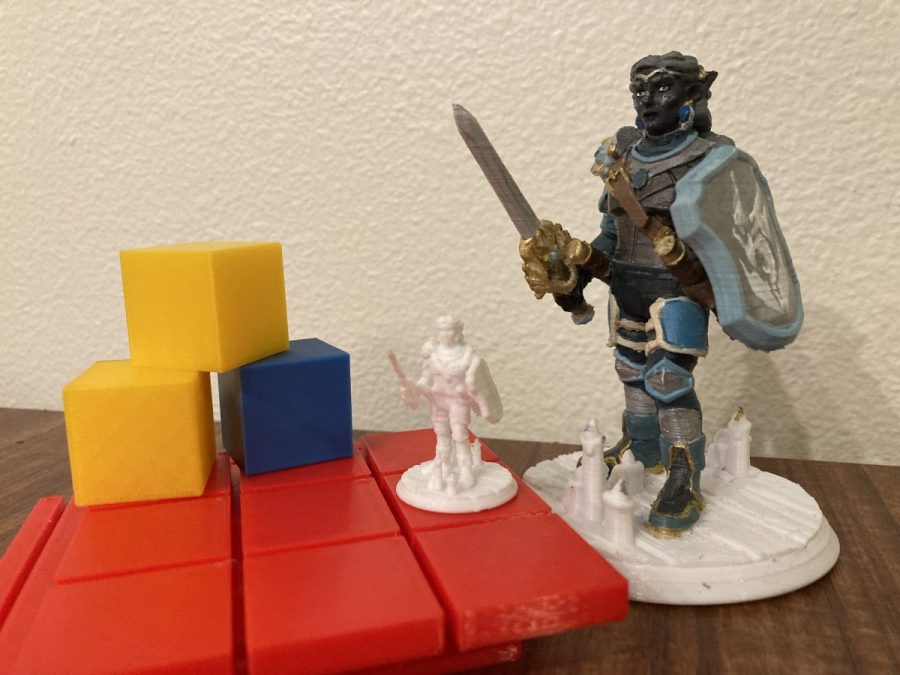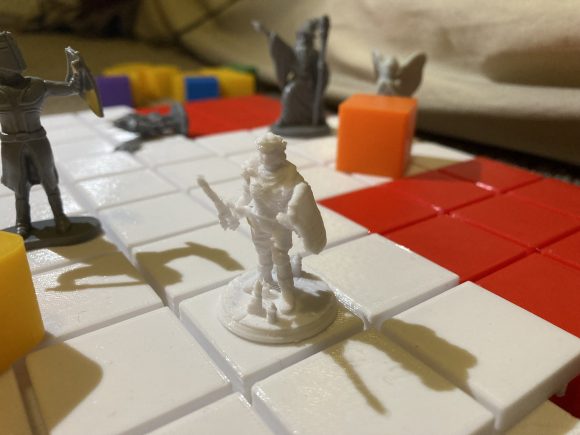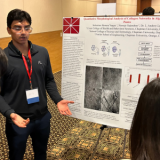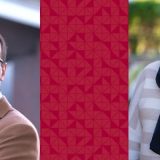
Fowler Engineering Helps Students Bring Advanced Manufacturing to Tabletop Gaming
December 19, 2022
When Brian Kirsch (‘23, Theater) first heard about Fowler School of Engineering’s (FSE) 3D Printing and Design course, he signed up hoping for a fun elective to fill a gap in his schedule. Throughout the semester, Kirsch’s classwork has enabled him to combine two distinct and vibrant worlds: fabrication and tabletop gaming.

A game piece from Brian Kirsch’s final project.
Kirsch, who has played the tabletop roleplaying game Dungeons & Dragons for nine years, cited this course as a meaningful opportunity for learning to create customizable, 3D-printed tabletop pieces anyone could physically play with. He expressed appreciation for how these custom props make his games more immersive and visual.
“When you see your character surrounded by zombies, or when the dragon figure is ten times larger than your own, it adds a lot more drama to it,” Kirsch said. “You can actually see what’s going on.”
Kirsch’s final project involves applying technology used in the classroom to develop modular, interlocking terrain plates for Dungeons & Dragons games. The design consists of square base plates that lock together to form the desired grid structure. Once these 3D-printed plates are linked up, players can use them as a customizable game board: they can place miniature figurines (colloquially known as minifigs) of characters, monsters, and objects on top of them, transforming the game into a more tangible experience.
“It’s cool to have the idea, ‘I want to make terrain,’ and now I’m holding it in my hand,” Kirsch stated. “It’s tangible, 3D, and something I created myself in this class.”
Kirsch is not the only student whose clever use of FSE technology has helped personalize tabletop gaming. For Chloe Leis (‘24, Film Production), her custom-designed tabletop pieces have allowed her to enhance the gaming experience even before it begins.
Much of Leis’ decade-long fabrication experience has focused around creating a variety of useful pieces for the strategy board game Gloomhaven. One of her most ambitious projects involved fabricating custom wood trays to hold the game’s numerous small parts. After an extensive process of laser cutting each piece, incorporating a dark wood stain, and engraving them with labels in a thematic medieval font, Leis admired her finished product: a series of unique tabletop organizers to call her own.
Chloe Leis’ final project
“When I bring out that game, I’m not just bringing out a game that I bought—it’s something more,” Leis shared. “This is my game now, it adds a personal touch to the experience. When I have people over, I can bring out this special version of the game that they’ve never played before.”
To Leis, the secret to personalizing games like Gloomhaven lies within the finishing process. The act of customizing tabletop pieces through painting, staining, or sanding can individualize the game to suit each player. Fortunately for the FSE and Chapman community, this much and more can be achieved through technology available in the makerspace.
“Here at Chapman, we have the Stratasys J850—our full color printer, an incredible piece of machinery to have access to as a student,” Leis explained. “Using it for coloring minifigs, for example, is incredible because they’re so tiny; learning how to hand-paint minifigs is tough, so being able to just make a digital texture and have that be on your finished product when it comes out of the printer is mind-blowing and game-changing.”
Like Leis, Computer Science major Jackson Goldberg (‘23) also saw tabletop gaming potential within the invaluable resources available to Chapman students. When his professor used makerspace technology to 3D-print a knight piece based on one of the oldest chess sets ever documented, Goldberg was inspired by the printer’s ability to achieve the same texture and coloring as the real-life chess pawn.
“I was thinking of how to use this printer, and I had made my own chess board and wanted to make my own pieces for the set,” Goldberg said. “Since I work in the tech shop, I got the idea to scan my coworkers’ faces and superimpose them onto chess pieces.”
Having played chess his entire life, Goldberg embraced the challenge of combining this interest with his more recent love of 3D printing. Though still in the early stages of development and troubleshooting, his process for designing custom chess pieces would begin by scanning fellow FSE students’ faces, placing them in a three-dimensional, virtual space. Then, Goldberg would use digital editing software to blend their faces with traditional chess model pieces. The final result would then be printed using the Stratasys J850.
Goldberg shared his excitement about seeing what FSE’s makerspace technology could accomplish. “With the quality of our scanner and printer, the level of precision is going to be really high throughout the entire process. With the old, hand-carved pieces, there’s only so much detail you can get, but this printer will be able to pick up on the crevices of the face, the textures of their skin. I’m looking forward to seeing that level of detail.”
“That’s what I love about 3D printing,” said Goldberg. “This technology can make anything you can imagine—the literal only limit is your own creativity.”


